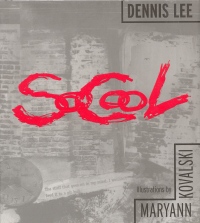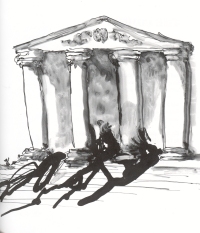| ________________
CM . . .
. Volume XI Number 9 . . . .January 7, 2005
excerpt: Pimples and zits,
Most early years students will meet, or have already met, the rollicking poetry of Dennis Lee through collections like Alligator Pie and Garbage Delight, but now middle schoolers have their own collection of his poetry, much of which speaks to them in terms of where they are in their own growing towards adulthood. The 36 poems in So Cool range in length from the eight lines of "Spell for Growing" to the 26 four-line verses of "Inspector Dogbone Gets His Man" which, with illustrations, are spread over six pages. Some of the poetry directly addresses the developmental tasks of adolescence. For instance, the opening poem, which is also the title poem, considers the physical changes which occur during this growth phase, changes which leave some boys, at least temporarily, with voices that seem to be pitched too high or with physiques which are puny when compared to the "cool" guys. Wet dreams, rarely the content of juvenile poetry, become the focus of "Me and the Ultimate Sensual Experience." The task of achieving an easy relationship with members of the opposite sex is the subject matter of "French Kissing with Gum in Your Mouth" as a worried adolescent male contemplates engaging in his first kiss. A further developmental task, that of establishing a new relationship with parents, is most movingly explored in "The Combat," a poem that parents should also read. Achieving new relationships with people your own age is the developmental task developed in "The Shame" and "The Pest." The different forms of loneliness in adolescence are Lee's topics in "The House of Alone," "Rainy Day Night," "The Other Place" and "Quiz." Some poems, like the tongue-twister "Who Cans Toucans?" and the rhythmical "Popping Pimples in the Park" and "Dorks from Outer Space" are essentially just plain fun. Lee also uses his poetry to gently and non-didactically offer advice to his middle school readers. In poems like "Back When I Never Knew" and "Living the Life," middle schoolers are encouraged to enjoy the moment while "Instructions" and "Curse and Farewell" discourage them from becoming conformists. Still others, such as "Children of Tomorrow" and "Deeper," encourage looking thoughtfully towards the future. An adolescent's first experience with death is often that of a beloved pet, and that experience is explored by Lee in "Red Rover." And then there are poems, such as "The Coat" and "Long Chant" which call for readers to bring their own meanings to the poems' contents. As a reality check, all teachers should read "What I Learned in Math Today."
Because the male pronoun is found more often than the female in the contents of So Cool, perhaps reluctant-poetry-reading middle years boys may be enticed to pick up and browse through the collection and sample its offerings, some of which are for the moment while others invite unhurried, reflective introspection. Highly Recommended. Dave Jenkinson teaches courses in children's and adolescent literature in the Faculty of Education, the University of Manitoba, Winnipeg, MB.
To comment
on this title or this review, send mail to cm@umanitoba.ca.
Copyright © the Manitoba Library Association. Reproduction for personal
use is permitted only if this copyright notice is maintained. Any
other reproduction is prohibited without permission.
NEXT REVIEW |
TABLE OF CONTENTS FOR THIS ISSUE
- January 7, 2005.
AUTHORS |
TITLES |
MEDIA REVIEWS |
PROFILES |
BACK ISSUES |
SEARCH |
CMARCHIVE |
HOME |

 In illustrating So Cool Kovalski effectively works in black, white and grey. In some instances, such as that of the facing poems, "Enough" and "High Summer" or the single poem "Red Rover," Kovalski is able to create a double page spread. "To My Friend, the Total Loser," a poem about males' seeming inability to express emotions related to the depth of same-sex friendship, is rendered in a comic strip/book format that extends over six pages. "What I Learned in Math Today" is cleverly presented on a sheet of lined notebook paper, its margins adorned with the doodles of the less-than-engaged student. Many of the illustrations, such as those accompanying "Spell for Growing," "The Mystery" and "Back When I Never Knew," are more abstract. Still other poems, like "Quiz" and "The Other Place" are simply presented without an illustration.
In illustrating So Cool Kovalski effectively works in black, white and grey. In some instances, such as that of the facing poems, "Enough" and "High Summer" or the single poem "Red Rover," Kovalski is able to create a double page spread. "To My Friend, the Total Loser," a poem about males' seeming inability to express emotions related to the depth of same-sex friendship, is rendered in a comic strip/book format that extends over six pages. "What I Learned in Math Today" is cleverly presented on a sheet of lined notebook paper, its margins adorned with the doodles of the less-than-engaged student. Many of the illustrations, such as those accompanying "Spell for Growing," "The Mystery" and "Back When I Never Knew," are more abstract. Still other poems, like "Quiz" and "The Other Place" are simply presented without an illustration.